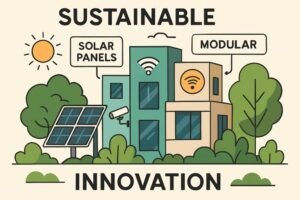Construction
Designing for Modern Construction Trends in 2025
Key Takeaways
- Sustainable and Eco-Friendly Designs: Growing prioritization of green materials and technologies.
- Modular and Prefabricated Construction: Increasing reliance on factory-built components for speed and quality.
- Smart Home Integration: Widespread use of IoT devices for convenience and efficiency.
- Adaptive Reuse: Revamping older properties instead of new builds to minimize waste and preserve history.
- Biophilic Design: Greater inclusion of natural elements for improved occupant well-being.
As the construction industry advances into 2025, professionals are navigating dynamic trends that fundamentally change how we shape our built environments. Architects, builders, and developers who stay up-to-date with these developments are better positioned to meet client demands and elevate project standards. The need for creative design, sustainable materials, and efficiency is more pronounced than ever—a direction exemplified by many leaders in the industry, such as general contractor Fort Lauderdale. Their approach to integrating new trends emphasizes how forward-thinking solutions drive not only functionality but also lasting value.
Today’s projects must strike a balance between innovation and environmental responsibility, leveraging emerging technologies and resource-efficient practices. Whether it’s optimizing energy use through smart systems or reimagining dated structures, embracing these trends unfolds new opportunities for buildings and communities alike. Modern construction isn’t just about following the latest style—it’s about making strategic choices that prioritize sustainability, efficiency, and the human experience.
Sustainable and Eco-Friendly Designs
Eco-conscious construction ranks as a top priority for 2025, with architects and builders opting for materials that support environmental stewardship. Products such as recycled steel, reclaimed wood, cork, and responsibly sourced bamboo replace traditional, more harmful building approaches. This mindset extends beyond material choice; it encompasses high-efficiency systems, such as advanced HVAC, triple-glazed windows, and renewable-powered building operations.
LEED certification and other green building standards are now mainstream goals, ensuring developments minimize energy consumption and maximize indoor air quality. Sustainable building also means future-proofing properties against rising energy costs, the impacts of climate change, and evolving regulatory expectations. As seen in a recent Architectural Digest article, major urban projects are increasingly driven by energy performance and lifecycle thinking—factors that guide both new construction and upgrades of existing sites.

Modular and Prefabricated Construction
Factory-built construction is rapidly transforming the industry’s pace and consistency. Modular systems—where kitchens, bathrooms, walls, or even entire modules are manufactured off-site—streamline timelines and reduce job site disruptions. Projects that might have taken months to complete through traditional building methods can now be delivered in a fraction of the time, while maintaining high precision and lower costs.
Especially in dense urban settings where space, labor, and time are at a premium, modular construction allows for better control over quality and material usage. These efficiencies significantly reduce on-site waste and emissions, contributing to sustainability targets while optimizing budgets. Cities like New York and London have seen a surge in high-rise modular buildings, proving the method’s scalability and aesthetic versatility.
Smart Home Integration
Intelligent technologies are no longer a luxury—they are an expectation. From automated lighting and HVAC controls to integrated security cameras, today’s homes are designed to be both energy efficient and highly responsive. Internet of Things (IoT) devices enable occupants to monitor and adjust their environments using smartphones or voice commands, significantly enhancing comfort and safety.
But smart integration goes further: it anticipates wear and maintenance needs, automates climate settings based on occupancy, and balances grid use through adaptive energy management systems. These advancements have not only transformed luxury custom homes but are also trickling down to affordable housing and multifamily developments, ensuring that smart infrastructure becomes a new industry standard.
Adaptive Reuse
Adaptive reuse presents an innovative way to marry history and modern needs, breathing new life into underutilized or obsolete structures. Whether converting factories into vibrant office spaces or transforming dated malls into residential complexes, the practice maintains architectural character while supporting sustainability. By favoring adaptation over new builds, communities benefit from reduced material waste, lower carbon emissions, and the preservation of local heritage—vital in rapidly evolving cityscapes.
Successful adaptive reuse often requires a creative blend of restoration and modernization, such as reinforcing old facades with high-performance envelopes or updating MEP systems to meet current codes. According to the New York Times, major U.S. cities are leveraging adaptive reuse to address urgent housing shortages while supporting sustainable growth.
Biophilic Design
The trend towards biophilic design highlights the growing body of research connecting natural environments to human well-being. Spaces infused with greenery, cascading light, and water elements not only appeal aesthetically but also support mental and physical health. Companies and homeowners alike are incorporating indoor gardens, living walls, natural wood accents, and expansive windows to bridge the gap between indoor and outdoor spaces.
Studies have shown that occupants of biophilic environments experience greater productivity, lower stress levels, and enhanced creativity. In the post-pandemic era, where remote and hybrid work is increasingly common, designing workspaces that support occupant health and comfort has never been more crucial. These nature-inspired practices are shaping everything from schools to commercial offices, indicating a lasting influence on global construction priorities.
Conclusion
The construction landscape of 2025 is characterized by an emphasis on innovation that is grounded in sustainability, usability, and human-centered values. Professionals who adapt to these trends—whether by selecting efficient materials, leveraging modular assemblies, integrating smart systems, repurposing older buildings, or bringing nature indoors—are positioned to deliver not only modern, resilient projects, but also real enhancements in the quality of life for occupants and communities.











